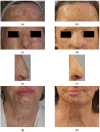Vacuum and Electromagnetic Fields Treatment to Regenerate a Diffuse Mature Facial Scar Caused by Sulfuric Acid Assault
- PMID: 36551005
- PMCID: PMC9774184
- DOI: 10.3390/bioengineering9120799
Vacuum and Electromagnetic Fields Treatment to Regenerate a Diffuse Mature Facial Scar Caused by Sulfuric Acid Assault
Abstract
Acid attacks are on the rise, and they cause extensive and deep burns, especially on the face. The treatments used to improve the aesthetic, functional and social impact of non-acid scars do not always prove useful for acid scars. This article reports the case of a woman with an extended, mature, acid facial scar, caused by sulfuric acid assault, treated with a recent new procedure that combines the application of vacuum and electromagnetic fields. Before and after the treatment, the aesthetic appearance, and motor function of the face and neck were evaluated, as well as the level of hydration, the amount of sebum, the elasticity, and the pH of the skin. The improvements highlighted after the treatment of the aesthetic and functional characteristics of the face and neck, and of the physical parameters of the skin seemed to indicate that this particular treatment induces tissue regeneration, even in the nerve component. However, it is evident that the rehabilitation pathways of facial wounds and scars must be personalized, and must include continuous psychological support for the patient.
Keywords: V-EMF; acid attack; burn; regenerative treatment; scar.
Conflict of interest statement
The authors declare no conflict of interest.
Figures
Similar articles
-
Electromagnetic Fields, Electrical Stimulation, and Vacuum Simultaneously Applied for Major Burn Scars.Bioengineering (Basel). 2025 Feb 13;12(2):179. doi: 10.3390/bioengineering12020179. Bioengineering (Basel). 2025. PMID: 40001698 Free PMC article.
-
V-EMF treatment of facial scar: First results.J Tissue Viability. 2022 Nov;31(4):614-618. doi: 10.1016/j.jtv.2022.07.006. Epub 2022 Jul 15. J Tissue Viability. 2022. PMID: 35853796
-
Vacuum and electromagnetic field in synergy for skin rejuvenation: A retrospective study on 217 patients.J Cosmet Dermatol. 2023 Nov;22(11):2989-2995. doi: 10.1111/jocd.15871. Epub 2023 Jun 20. J Cosmet Dermatol. 2023. PMID: 37340588
-
Topical treatment for facial burns.Cochrane Database Syst Rev. 2020 Jul 29;7(7):CD008058. doi: 10.1002/14651858.CD008058.pub3. Cochrane Database Syst Rev. 2020. PMID: 32725896 Free PMC article.
-
[Reconstruction of facial burn sequelae].Ann Chir Plast Esthet. 2001 Jun;46(3):210-26. doi: 10.1016/s0294-1260(01)00021-8. Ann Chir Plast Esthet. 2001. PMID: 11447626 Review. French.
Cited by
-
Electromagnetic Fields, Electrical Stimulation, and Vacuum Simultaneously Applied for Major Burn Scars.Bioengineering (Basel). 2025 Feb 13;12(2):179. doi: 10.3390/bioengineering12020179. Bioengineering (Basel). 2025. PMID: 40001698 Free PMC article.
-
Open-Label Uncontrolled, Monocentric Study to Evaluate the Efficacy and Safety of the Electromagnetic Field and Negative Pressure in the Treatment of Cellulite.Life (Basel). 2025 Jul 21;15(7):1148. doi: 10.3390/life15071148. Life (Basel). 2025. PMID: 40724650 Free PMC article.
-
Early reconstruction of the ilioinguinal lobed flap in the treatment of facial and neck sulfuric acid burn: A case report.Trauma Case Rep. 2025 Jul 10;58:101215. doi: 10.1016/j.tcr.2025.101215. eCollection 2025 Aug. Trauma Case Rep. 2025. PMID: 40689389 Free PMC article.
-
Hyper- and Hypopigmentation in a Subject with Fitzpatrick Skin Phototype VI: A New Treatment Option.J Clin Med. 2024 Feb 11;13(4):1036. doi: 10.3390/jcm13041036. J Clin Med. 2024. PMID: 38398349 Free PMC article.
References
LinkOut - more resources
Full Text Sources


